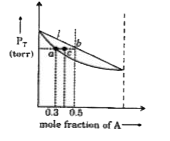Assertion (A) :KCl is more likely to show Schottky defect, while Lil is more likely to show Frenkel defect.
Reason(R): Schottky defects is more likely in ionic solids in which cations and anions are of comparable size while Frenkel defect is more likely in which cations and anions have large differences in their ionic sizes.Solution in Malayalam
If both Assertion and Reason are true and the Reason is the correct explanation of Assertion.
If both Assertion and Reason are true but Reason is not the correct explanation of Assertion
If Assertion is true but the Reason is false
If both Assertion and Reason are false
Step by step video & image solution for Assertion (A) :KCl is more likely to show Schottky defect, while Lil is more likely to show Frenkel defect. Reason(R): Schottky defects is more likely in ionic solids in which cations and anions are of comparable size while Frenkel defect is more likely in which cations and anions have large differences in their ionic sizes. by Chemistry experts to help you in doubts & scoring excellent marks in Class 12 exams.
Updated on:21/07/2023Topper's Solved these Questions
- SOLID STATEBOOK - BRILLIANT PUBLICATIONCHAPTER - SOLID STATEEXERCISE - QUESTION
14 Videos
- SOLID STATEBOOK - BRILLIANT PUBLICATIONCHAPTER - SOLID STATEEXERCISE - LEVEL-I
50 Videos
- SOLID STATEBOOK - BRILLIANT PUBLICATIONCHAPTER - SOLID STATEEXERCISE - QUESTION (LEVEL -II)
31 Videos
- REDOX REACTION & ELECTROCHEMISTRYBOOK - BRILLIANT PUBLICATIONCHAPTER - REDOX REACTION & ELECTROCHEMISTRYEXERCISE - QUESTION (ELECTROCHEMISTRY) (LEVEL -II) (ASSERTION-REASON)
3 Videos
- SOLUTIONSBOOK - BRILLIANT PUBLICATIONCHAPTER - SOLUTIONSEXERCISE - Level-III (Linked Comprehension Type)
12 Videos
Similar Questions
A compound of elements X and Y crystallizes in cubic structure where X atoms occupy the corners of the cube and Y atoms occupy the centre of the cube. What is the formula of the compound?
View SolutionThe radius of a di val ent cation M2+ is 94 pm and of divalent anion X2− is 146 pm. Thus, M2X2− has
View SolutionMost unsymmetrical and symmetrical systems are respectively
View SolutionAssertion: After the electrolysis of aqueous CuSO4 solution pH decreases.
Reason: Sulphuric acid is formed.
View Solution1 mole of A and 1 mole B are mixed together to form an ideal solution at 25∘C. Solution is placed in a vessel fitted with piston. If pressure on the solution is reduced isothermally.

Correct relationship between P∘AandP∘B is
View SolutionFrenkel defects asre observed where the differnce in size of cation and anion is large
View SolutionOn the basis of the nature of ionic solids, compare Frenkel defect with Schottky defect.
View Solution(A) KCL is more likely to show Schottky defect ,while Li is more likely to show Frenkel defect. (R) Schottly defect is found in those ionic solid which have cation and anion of similar size while Frenkel defect is more likely found in those solids which have cation of smaller size.
View SolutionAssertion : Due to Frenkel defect, density of the crystalline solid decreases. Reason : In Frenkel defect, cation or anion leaves the crystal.
View SolutionName a crystalline solid which is likely to develop both Schottky and Frenkel defects.
View SolutionAssert : due to Frenkel defect, density of the crystalline solid decrases. Reason : in Frenkel defect cation and anion leaves the crystal.
View SolutionName the ionic solid which shows both Schottky defect and Frenkel defect.
View SolutionGive example for Schottky defect and Frenkel defect ionic solids?
View SolutionAssertion : due to Frenkel defect, density of the crystalline solid decreases. Reason : in Frenkel defect cation and anion leaves the crystal.
View SolutionName any ionic solid in which both Frenkel and Schottky defects occur.
View Solution
